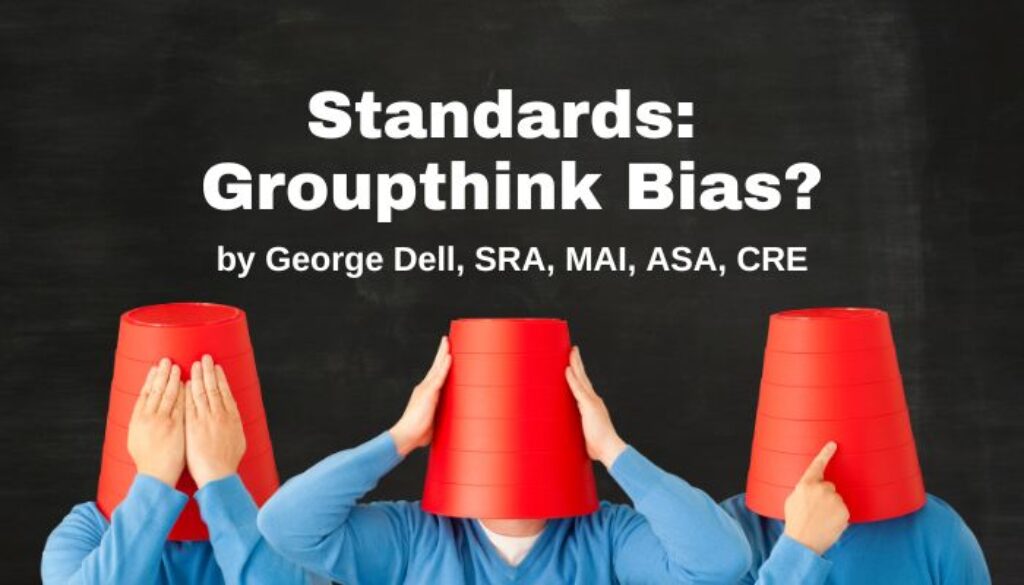We continue our look at how current standards, and regulations hold back best practices.
This part 5 of a multipart look at issues in valuation standards. Editor’s Note: This is Standards, part 3.5 of George Dell’s series on How Do I Move to EBV? Links to the earlier posts are here.
This part is interesting in that it really more of a look at human behavior. This in the darkness of bias covered by personal purpose. And by the groupthink of accepted exception . . .
Market value. What is it? Easy, right?
So, what is a “market?” And what is “value?”
Here, we look at two issues:
- Is “price” a good measure of value?
- Do we respect the FHFA/GSE definition of value?
Warren Buffett’s most famous quotes (via Benjamin Graham) is, “Price is what you pay; value is what you get.” This statement seems simple, but opens up several financial and motivational issues.
PRICE AS VALUE
A place to live, entertain, have sex, eat, and feel safe – is not all! Buyer motivation also includes wealth-building, cyclical speculation, over-exuberance, currency/political hedging, an alternative to renting, ‘trophy-property’ prestige, and just plain land banking.
If we consider today’s housing collateral risk value (like the GSEs), that (downside risk) value should be quite different from the upside potential value of an investor or speculator. In fact, each of the above will have a different buyer value as from market price.
Buyer value is not price, except by accident.
Admittedly users, such as the GSEs adjust the market price to suit current risk or greed measures. We can call this the risk/greed tradeoff. For lending, the greater the personal benefit, whether a commission, or a promotion, or an annual bonus – the higher is the personal risk tolerance, (with a transfer of the loss risk to the public – today the FHFA and “interagency” regulators).
Price is different from the value to a particular buyer/investor. Value is, and should be, different for a collateral investor or an equity investor. Lender safety is always subject to great tail-risk price losses, but gain nothing from tail-risk price gains. Conversely, investors can compensate tail-risk losses against tail-risk gains. (Tail risk can be defined as ‘black swan’ events, occurring rarely, but regularly!)
GROUPTHINK
In several prior blogs and papers (read them here) we have described how groupthink long has taken priority over the actual definition of market value, as currently required by our GSEs, and as written in the USPAP Advisory Opinion 22. This “market value” requires certain conditions and assumptions. In brief:
- A “most probable price” (which mathematically does not exist);
- Buyer and seller are prudent and knowledgeable (homebuyers are seldom knowledgeable);
- No undue stimulus, (such as protection from downside tail risk);
- “Based on a market perspective” (which we know should be a personal value perspective);
- “Typical” motivation, (which we know does not exist);
- Parties are well-informed or well-advised (a questionable motive of commissioned agents);
“Market [price] perspective replaces a user’s perspective.” Price may not be the best value to apply to loans, investments, speculations, personal use, or even for any “reparation” or other socially adjusted or special-benefit or special-punishment value.
The above conditions and assumptions are industry-disregarded. This is groupthink.
It doesn’t matter if its not true. So long as everyone goes along. Groupthing.

June 28, 2023 @ 7:45 am
An appraiser does not measure the value to an individual user or some mythical market, an appraiser measures the value to the potential pool of limited buyers willing and able to purchase that property.
Real estate is unlike any other good or commodity because of its immobility. Realty cannot be moved to a better location where it could sell for a higher price or away from an undesirable neighbor, it must be used where it lies. As such, the discussions about supply/demand, price/value, market cycles, and equilibrium are different than those about buying an app for your cell phone, cars, shoes or groceries. The old axiom that real estate is all about location, location, location is true in that the buyer is only mobile until they become the owner, at which point the real estate’s utility and value is all about the property itself, its fixed location, its access, its neighbors, its market, and its surroundings. And because real estate is immobile it can become unusable and ownership can be lost or removed due to the vestiges of that location (accretion, reliction, erosion, contamination, flooding, earthquakes, etc.). The productive use of real estate must be produced and enjoyed at its particular location or not at all.